Exhibition dates: 29th January – 4th June 2017
Curators: Alan Govenar, with Martina Caruso, Collections Manager and Registrar, and Michelle Kennedy, Collections Assistant at the Seaport Museum
Tattooing Tools
c. 1900-1940 (metal, wood, bone, plastic, textile, paper)
Courtesy South Street Seaport Museum
THIS IS THE FIRST POSTING SINCE MY OPERATION. THIS AND THE NEXT FEW POSTINGS WERE CREATED WELL BEFORE THE OPERATION. I AM NOT USING MY INJURED HAND WHICH IS IN A CAST UNTIL THE 15th JUNE 2017. THANK YOU!
I love the (hand coloured) photographs of Australia and New Zealand among the pages of the Souvenirs of the Travels and Experiences of the Original Gus Wagner, Globe Trotter & Tattoo Artist scrapbook, and the photographs of early Australian tattooing.
The ink work over the background photograph of Victor Lundblad (?) tattooed by Gus Wagner 1902 (left) and Gus Age 30 (right) (1902, below) adds an altered dimension to the photographic image, both physical and visual … from the hand coloured roses on the studio background, to the all seeing eyes staring at the viewer on the back of Victor Lundblad’s legs and on to the eyelashes of both men, which are like that of a Victorian doll. The male body as tattoo schematic, as a representational topography.
Dr Marcus Bunyan
Many thanks to the South Street Seaport Museum for allowing me to publish the artwork in the posting. Please click on the photographs for a larger version of the image.
“There is something about tattooing which I cannot explain… and why so many people have it done I don’t know. It may be vain, but I find it fascinating and very useful in traveling. Every symbol and every design made up of symbols has a meaning. These on my body, for instance, are mementos featuring incidents of my life and travels. Then, too, in every country where tattooing is practiced a tattooed person who is able to tattoo needs to further introduction to the natives, be they civilised or uncivilised, or even barbaric and cannibalistic.”
Gus Wagner
Tattooing Tools
c. 1900-1940 (metal, wood, bone, plastic, textile, paper)
Courtesy South Street Seaport Museum
Augustus “Gus” Wagner (American, 1872-1941)
Souvenirs of the Travels and Experiences of the Original Gus Wagner, Globe Trotter & Tattoo Artist scrapbook
c. 1897-1941
Leather, paper, photographic print, ink, thread
Courtesy South Street Seaport Museum
Augustus “Gus” Wagner (American, 1872-1941)
Pages from Souvenirs of the Travels and Experiences of the Original Gus Wagner, Globe Trotter & Tattoo Artist scrapbook
c. 1897-1941
Leather, paper, photographic print, ink, thread
Courtesy South Street Seaport Museum
Augustus “Gus” Wagner (American, 1872-1941)
Taken on board R.M.S. Ormuz in Sydney Harbor Sydney new South Wales Australia, March 1899
1899
Pages from Souvenirs of the Travels and Experiences of the Original Gus Wagner, Globe Trotter & Tattoo Artist scrapbook (detail)
c. 1897-1941
Leather, paper, photographic print, ink, thread
Courtesy South Street Seaport Museum
(colour correction and light digital clean)
RMS Ormuz, built in the Glasgow shipyards and she was capable of sailing from Sydney, as it was advertised locally, to London in just 30 days. The truth is that she was indeed capable, and she even did it once, however, filled with passengers and with suitable ports of call for the enjoyment of the ships guests, the voyage would usually take six weeks…
In 1883 The Orient Steam Navigation Co. Ltd., of London signed a contract with the Government of New South Wales, Australia to carry emigrants from the United Kingdom. The Company would be paid £15 per head for up to four hundred persons and £14 and 10 Shillings for numbers between four and six hundred persons per voyage…
Having been carefully planned and using one of the company’s finest interior designers, such as J. J. Stevenson F.R.I.B.A., who had already worked on a number of earlier ships and would now place his stamp on the Ormuz! Thus an order was placed for her to be built at Fairfield Shipbuilding and Engineering Co. Ltd., Glasgow, where her hull was laid down in Yard 317.
The new almost completed liner was officially launched on September 29, 1886 and after her fit-out and trials were completed, on December 29, 1886 she was registered at Glasgow in the ownership of the Orient Steam Navigation Co. Ltd., London, named the “Ormuz.” She was then officially handed over to the Orient Line at Tilbury.
The 6,031 GRT (Gross Registered Ton) RMS Ormuz was 464.5ft – 141.55m long and she accommodated 334 passengers in comfortable First and Second Class accommodations. In addition there were the more humble migrant accommodations, which were generally large all male and female dormitories with some 6 to 8 berth cabins and a few 4 berth cabins for ladies with babies, or very young children sailing. In all there would be 300 migrants onboard, thus a total of 634 passengers, that is if the ship was fully booked!
When it came to cargo she carried general cargoes in her five holds, but she did have 44,501 cubic feet of refrigerated cargo space to transport lamb, butter, and fruit from Australia to Great Britain, and as we have already ready it arrived in a fresh and excellent condition!
The RMS Ormuz departed on her maiden voyage from London (Tilbury) to Australia on February 3, 1887 and it was a most successful voyage. She received a wonderful welcome in Sydney as what was the grand new four mast twin funnelled Orient Line steamship, which for her day would have looked quite a sight as she entered Sydney in record time!
Having arrived again in Melbourne on November 20, 1887, the RMS Ormuz had improved on her earlier time, thus the very next day the “Melbourne Daily Telegraph” described the Ormuz as “The Fastest Ship in the World” on the basis that it had “placed the metropolis of the world within twenty-seven days six hours of its antipodes.”
Text from the ss Maritime website
Augustus “Gus” Wagner (American, 1872-1941)
Hobart, Tasmania, taken 1899 Years
1899
Pages from Souvenirs of the Travels and Experiences of the Original Gus Wagner, Globe Trotter & Tattoo Artist scrapbook (detail)
c. 1897-1941
Leather, paper, photographic print, ink, thread
Courtesy South Street Seaport Museum
Augustus “Gus” Wagner (American, 1872-1941)
Pages from Souvenirs of the Travels and Experiences of the Original Gus Wagner, Globe Trotter & Tattoo Artist scrapbook
c. 1897-1941
Leather, paper, photographic print, ink, thread
Courtesy South Street Seaport Museum
Augustus “Gus” Wagner (American, 1872-1941)
As seen by Gus
Pages from Souvenirs of the Travels and Experiences of the Original Gus Wagner, Globe Trotter & Tattoo Artist scrapbook (detail)
c. 1897-1941
Leather, paper, photographic print, ink, thread
Courtesy South Street Seaport Museum
Augustus “Gus” Wagner (American, 1872-1941)
Pages from Souvenirs of the Travels and Experiences of the Original Gus Wagner, Globe Trotter & Tattoo Artist scrapbook
c. 1897-1941
Leather, paper, photographic print, ink, thread
Courtesy South Street Seaport Museum
Augustus “Gus” Wagner (American, 1872-1941)
Sydney N.S.W. Australia
Pages from Souvenirs of the Travels and Experiences of the Original Gus Wagner, Globe Trotter & Tattoo Artist scrapbook (detail)
c. 1897-1941
Leather, paper, photographic print, ink, thread
Courtesy South Street Seaport Museum
Augustus “Gus” Wagner (American, 1872-1941)
New Castle N.S.W. Australia
Pages from Souvenirs of the Travels and Experiences of the Original Gus Wagner, Globe Trotter & Tattoo Artist scrapbook (detail)
c. 1897-1941
Leather, paper, photographic print, ink, thread
Courtesy South Street Seaport Museum
Augustus “Gus” Wagner (American, 1872-1941)
Gus shell hunting in the Islands (?)
Pages from Souvenirs of the Travels and Experiences of the Original Gus Wagner, Globe Trotter & Tattoo Artist scrapbook (detail)
c. 1897-1941
Leather, paper, photographic print, ink, thread
Courtesy South Street Seaport Museum
(colour correction and light digital clean)
Augustus “Gus” Wagner (American, 1872-1941)
tattooed by Gus Wagner 1899
1899
Pages from Souvenirs of the Travels and Experiences of the Original Gus Wagner, Globe Trotter & Tattoo Artist scrapbook (detail)
c. 1897-1941
Leather, paper, photographic print, ink, thread
Courtesy South Street Seaport Museum
Augustus “Gus” Wagner (American, 1872-1941)
tattooed by Gus Wagner 1901
1901
Pages from Souvenirs of the Travels and Experiences of the Original Gus Wagner, Globe Trotter & Tattoo Artist scrapbook (detail)
c. 1897-1941
Leather, paper, photographic print, ink, thread
Courtesy South Street Seaport Museum
The Original Gus Wagner: The Maritime Roots of Modern Tattoo explores Augustus “Gus” Wagner’s (American, 1872-1941) early life as a merchant seaman and tattoo artist who traveled the world from 1898-1902, and his return to the United States as a professional tattooist and tattooed man.
Gus Wagner was born in 1872 in Marietta, Ohio, a trading and boat building town on the Ohio River. At age twelve he saw his first heavily tattooed man, “Captain Costentenus the Greek Albanian,” in a traveling show. In his 20’s, he set out as an itinerant salesman and labourer. In 1897 he boarded the cargo steamer Bellona at Newport News, Virginia, thus embarking on a four-year career as a merchant seaman. By traveling around the world, Gus Wagner got to know many seaports: Vera Cruz, London, Cape Town, Sydney, Auckland, Honolulu, New York, San Francisco, and others. It was during this time that he discovered the art of tattooing.
By 1901 Gus reportedly had 264 tattoos of his own, (and over 800 by 1908) allowing him to promote himself as “the most artistically marked up man in America.” After briefly moving home to Ohio, Gus embarked on a forty-year career as a traveling tattooist, tattooed man, and circus performer. He largely eschewed the new electric tattooing machines that transformed the art form after 1890, and remained faithful to his hand-held instruments. With other wandering artists, he carried tattooing inland from coastal ports, making it part of the culture of small-town America in the 20th century.
The exhibition will show original and reproduced artefacts from the Seaport Museum’s Alan Govenar and Kaleta Doolin Tattoo Collection such as tattooing tools, a selection of tattoo flashes (drawings and sketches, on recycled paper based materials, displaying variations of tattoo designs) and a selection of pages from the artist’s scrapbook – a 400 page book composed of press clippings, postcards, business cards, sketches, and photographs, that relate to his introduction to tattooing as a sailor.
The exhibition will familiarise viewers with hand tattoo techniques, and make the case for the importance of researching, documenting, and preserving tattoo collections in museums and research institutes. Most of the artefacts are not on view due to their fragile condition and conservation needs. The reproductions and video projection in the exhibition are a testimony of the richness of Gus Wagner’s image vocabulary, his life and artistic influences, and a relatively unknown area of American history during the period from the 1890s to the 1930s.
The exhibition is curated by Alan Govenar, with Martina Caruso, Collections Manager and Registrar, and Michelle Kennedy, Collections Assistant at the Seaport Museum. The design and art direction is curated by Rob Wilson and Christine Picone of Bowne Printers, the Museum’s historic print shop.
Press release from the South Street Seaport Museum
Unknown photographer
Maud Stevens Wagner, tattoo artist
Nd
Maud Wagner (wife of Gus Wagner). Gus taught her to tattoo (in trade for a date, they say) and she was also an aerialist and contortionist in a circus.
Unknown photographer
Gus and Maude
Nd
Unknown photographer
Gus Wagner tattooing
Nd
Augustus “Gus” Wagner (American, 1872-1941)
Pages from Souvenirs of the Travels and Experiences of the Original Gus Wagner, Globe Trotter & Tattoo Artist scrapbook
c. 1897-1941
Leather, paper, photographic print, ink, thread
Courtesy South Street Seaport Museum
Augustus “Gus” Wagner (American, 1872-1941)
Jeneoffly (?). Australian By bennell Australia. Tattooed by John W. Bennell
c. 1901
Pages from Souvenirs of the Travels and Experiences of the Original Gus Wagner, Globe Trotter & Tattoo Artist scrapbook (detail)
c. 1897-1941
Leather, paper, photographic print, ink, thread
Courtesy South Street Seaport Museum
Augustus “Gus” Wagner (American, 1872-1941)
Pages from Souvenirs of the Travels and Experiences of the Original Gus Wagner, Globe Trotter & Tattoo Artist scrapbook
c. 1897-1941
Leather, paper, photographic print, ink, thread
Courtesy South Street Seaport Museum
Augustus “Gus” Wagner (American, 1872-1941)
Tattoo design from Souvenirs of the Travels and Experiences of the Original Gus Wagner, Globe Trotter & Tattoo Artist scrapbook (detail)
c. 1897-1941
Leather, paper, photographic print, ink, thread
Courtesy South Street Seaport Museum
Augustus “Gus” Wagner (American, 1872-1941)
Tattoo design from Souvenirs of the Travels and Experiences of the Original Gus Wagner, Globe Trotter & Tattoo Artist scrapbook (detail)
c. 1897-1941
Leather, paper, photographic print, ink, thread
Courtesy South Street Seaport Museum
Augustus “Gus” Wagner (American, 1872-1941)
Pages from Souvenirs of the Travels and Experiences of the Original Gus Wagner, Globe Trotter & Tattoo Artist scrapbook
c. 1897-1941
Leather, paper, photographic print, ink, thread
Courtesy South Street Seaport Museum
Augustus “Gus” Wagner (American, 1872-1941)
Pages from Souvenirs of the Travels and Experiences of the Original Gus Wagner, Globe Trotter & Tattoo Artist scrapbook
c. 1897-1941
Leather, paper, photographic print, ink, thread
Courtesy South Street Seaport Museum
Augustus “Gus” Wagner (American, 1872-1941)
Tattoo design from Souvenirs of the Travels and Experiences of the Original Gus Wagner, Globe Trotter & Tattoo Artist scrapbook (detail)
c. 1897-1941
Leather, paper, photographic print, ink, thread
Courtesy South Street Seaport Museum
Augustus “Gus” Wagner (American, 1872-1941)
Pages from Souvenirs of the Travels and Experiences of the Original Gus Wagner, Globe Trotter & Tattoo Artist scrapbook
c. 1897-1941
Leather, paper, photographic print, ink, thread
Courtesy South Street Seaport Museum
Augustus “Gus” Wagner (American, 1872-1941)
Tattoo designs from Souvenirs of the Travels and Experiences of the Original Gus Wagner, Globe Trotter & Tattoo Artist scrapbook (detail)
c. 1897-1941
Leather, paper, photographic print, ink, thread
Courtesy South Street Seaport Museum
Augustus “Gus” Wagner (American, 1872-1941)
Pages from Souvenirs of the Travels and Experiences of the Original Gus Wagner, Globe Trotter & Tattoo Artist scrapbook
c. 1897-1941
Leather, paper, photographic print, ink, thread
Courtesy South Street Seaport Museum
Augustus “Gus” Wagner (American, 1872-1941)
Tattoo designs from Souvenirs of the Travels and Experiences of the Original Gus Wagner, Globe Trotter & Tattoo Artist scrapbook (detail)
c. 1897-1941
Leather, paper, photographic print, ink, thread
Courtesy South Street Seaport Museum
Augustus “Gus” Wagner (American, 1872-1941)
Pages from Souvenirs of the Travels and Experiences of the Original Gus Wagner, Globe Trotter & Tattoo Artist scrapbook
c. 1897-1941; these photographs 1902
Leather, paper, photographic print, ink, thread
Courtesy South Street Seaport Museum
Augustus “Gus” Wagner (American, 1872-1941)
Victor Lundblad (?) tattooed by Gus Wagner 1902 (left) and Gus Age 30 (right)
1902
Page from Souvenirs of the Travels and Experiences of the Original Gus Wagner, Globe Trotter & Tattoo Artist scrapbook (detail)
c. 1897-1941
Leather, paper, photographic print, ink, thread
Courtesy South Street Seaport Museum
Augustus “Gus” Wagner (American, 1872-1941)
Victor Lundblad (?) tattooed by Gus Wagner 1902 (left) and Gus Age 30 (right)
1902
Page from Souvenirs of the Travels and Experiences of the Original Gus Wagner, Globe Trotter & Tattoo Artist scrapbook (detail)
c. 1897-1941
Leather, paper, photographic print, ink, thread
Courtesy South Street Seaport Museum
Augustus “Gus” Wagner (American, 1872-1941)
Victor Lundblad (?) tattooed by Gus Wagner 1902 (left) and Gus Age 30 (right)
1902
Page from Souvenirs of the Travels and Experiences of the Original Gus Wagner, Globe Trotter & Tattoo Artist scrapbook (detail)
c. 1897-1941
Leather, paper, photographic print, ink, thread
Courtesy South Street Seaport Museum
Augustus “Gus” Wagner (American, 1872-1941)
Victor Lundblad (?) tattooed by Gus Wagner 1902 (left) and Gus Age 30 (right)
1902
Page from Souvenirs of the Travels and Experiences of the Original Gus Wagner, Globe Trotter & Tattoo Artist scrapbook (detail)
c. 1897-1941
Leather, paper, photographic print, ink, thread
Courtesy South Street Seaport Museum
Augustus “Gus” Wagner (American, 1872-1941)
Self-Portrait, Tattoo Flash
c. 1910-1930
Photographic print, ink, cardboard
Courtesy South Street Seaport Museum
Augustus “Gus” Wagner (American, 1872-1941)
Self-Portrait, Tattoo Flash (detail)
c. 1910-1930
Photographic print, ink, cardboard
Courtesy South Street Seaport Museum
Augustus “Gus” Wagner (American, 1872-1941)
Self-Portrait, Tattoo Flash
c. 1910-1930
Photographic print, ink, cardboard
Courtesy South Street Seaport Museum
Augustus “Gus” Wagner (American, 1872-1941)
Self-Portrait, Tattoo Flash (detail)
c. 1910-1930
Photographic print, ink, cardboard
Courtesy South Street Seaport Museum
South Street Seaport Museum
12 Fulton Street
New York, NY 10038
Phone: 212-748-8600
Opening hours:
Saturday – Sunday 11.00am – 5.00pm




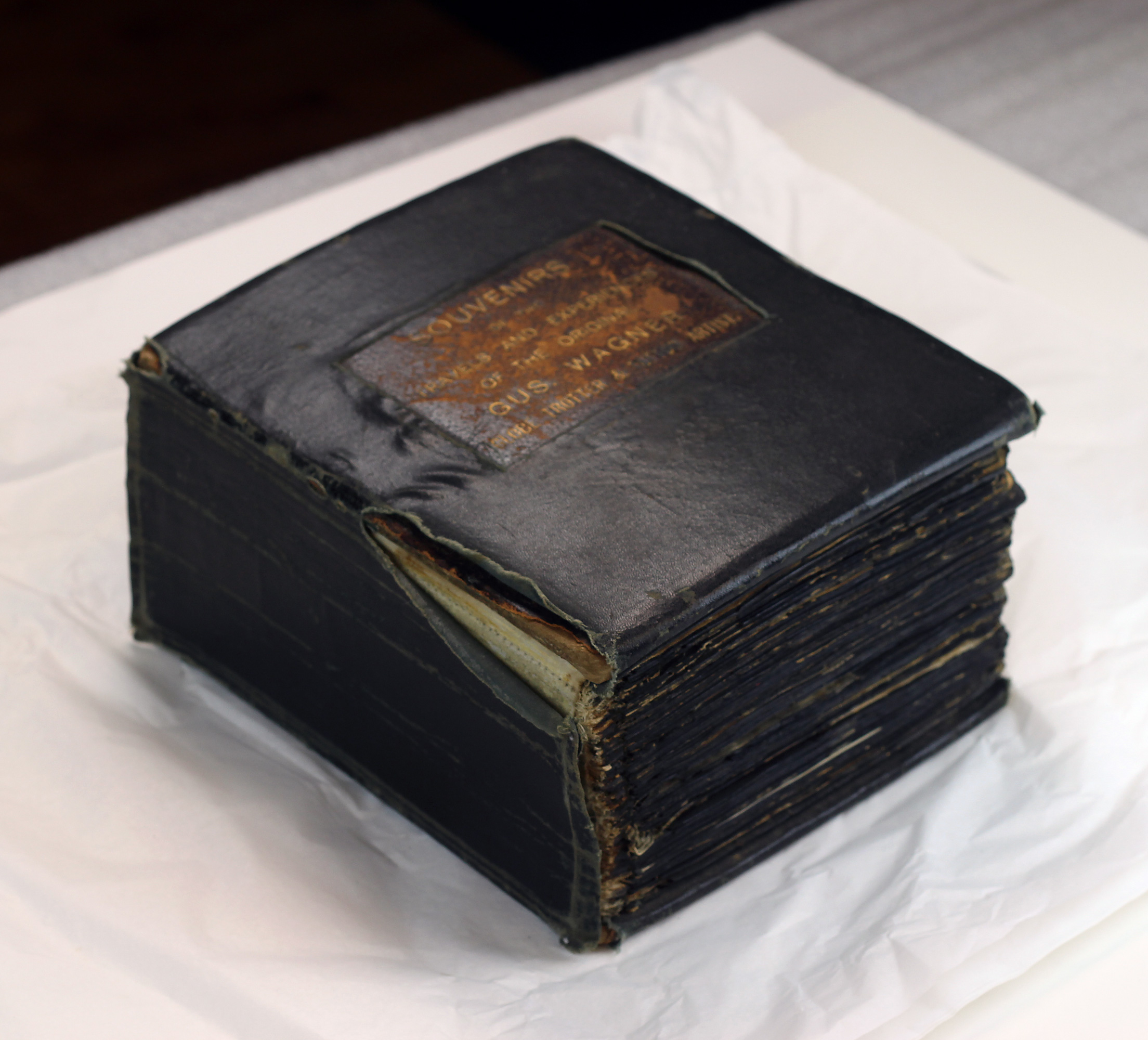




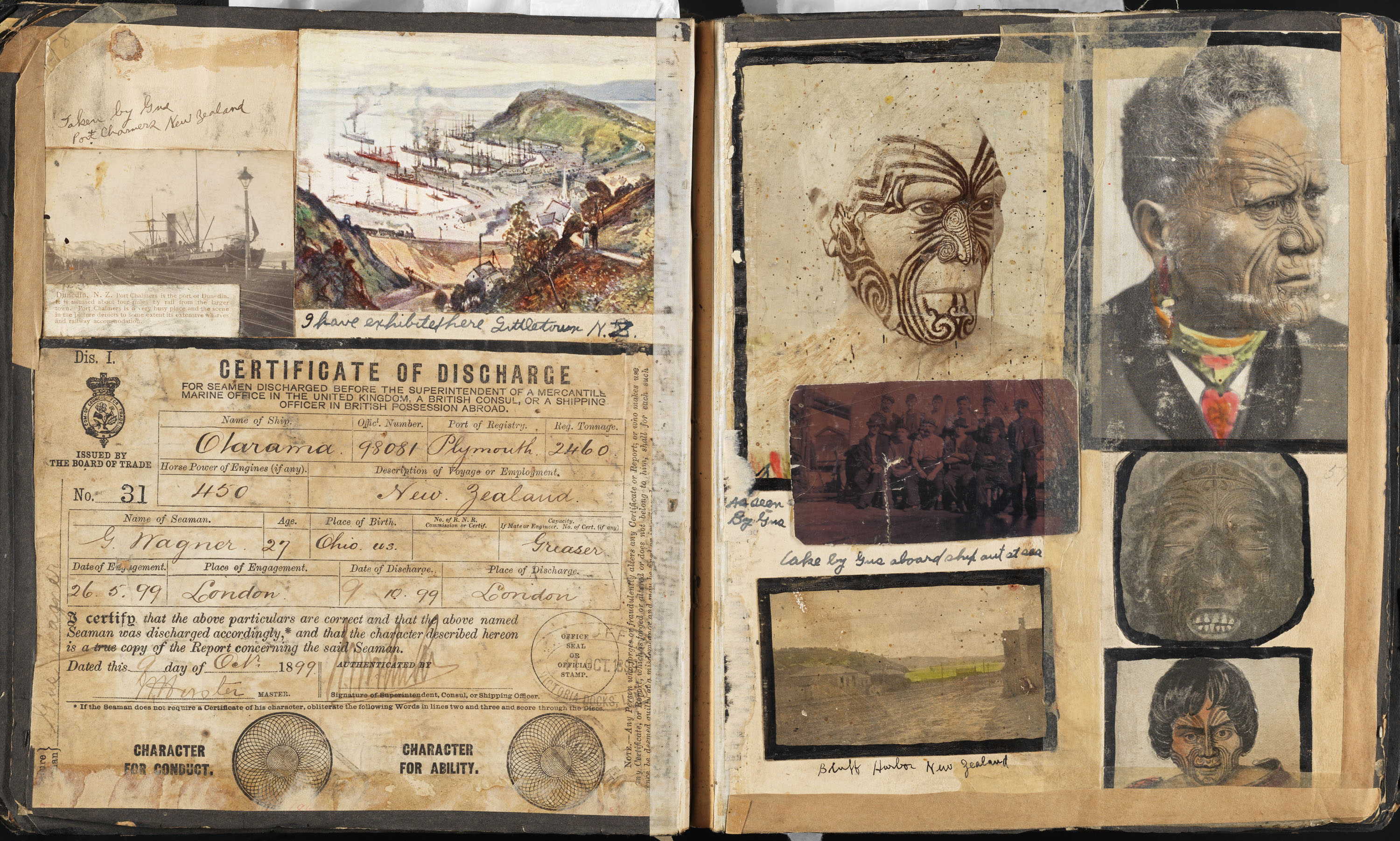


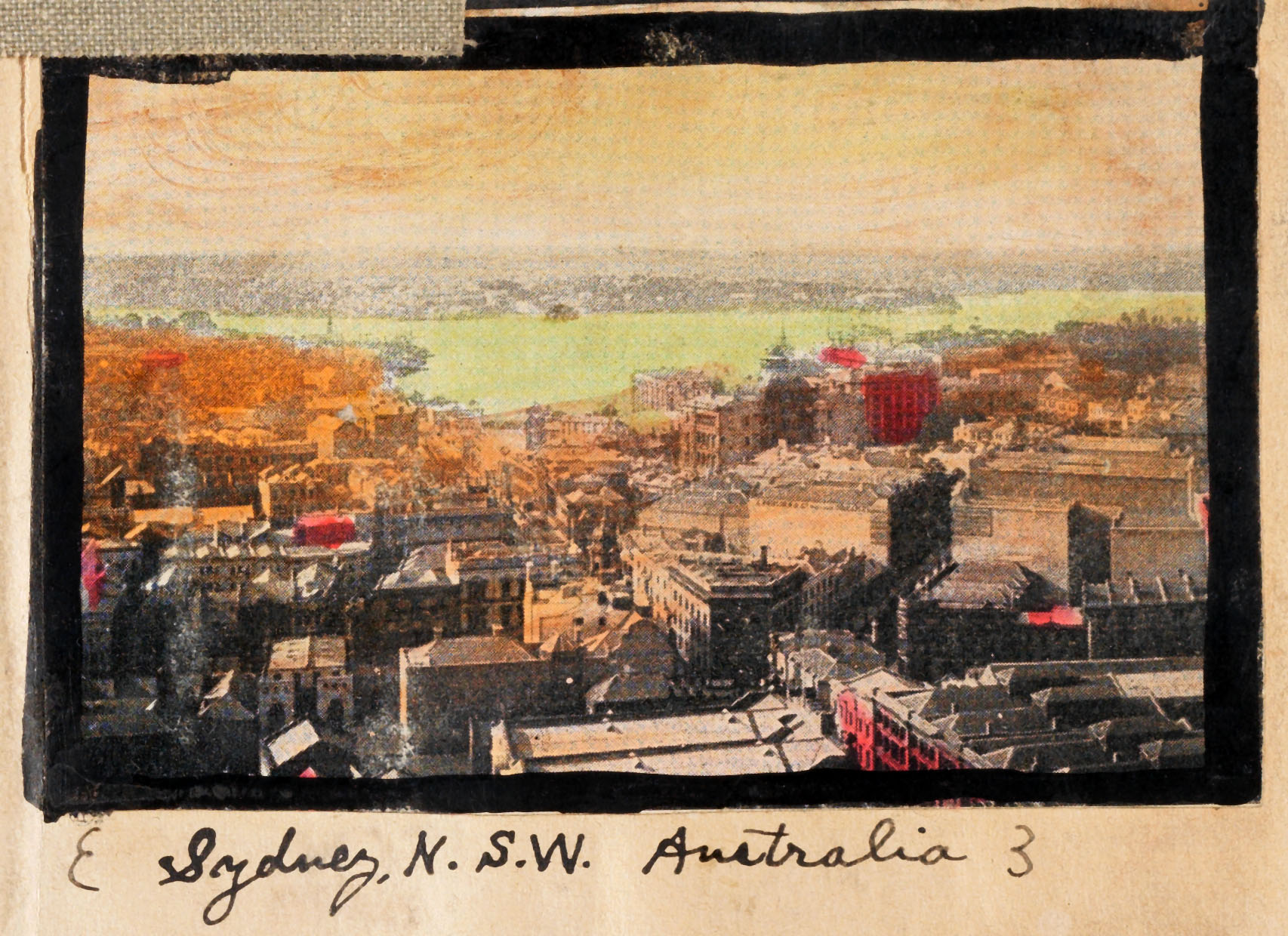









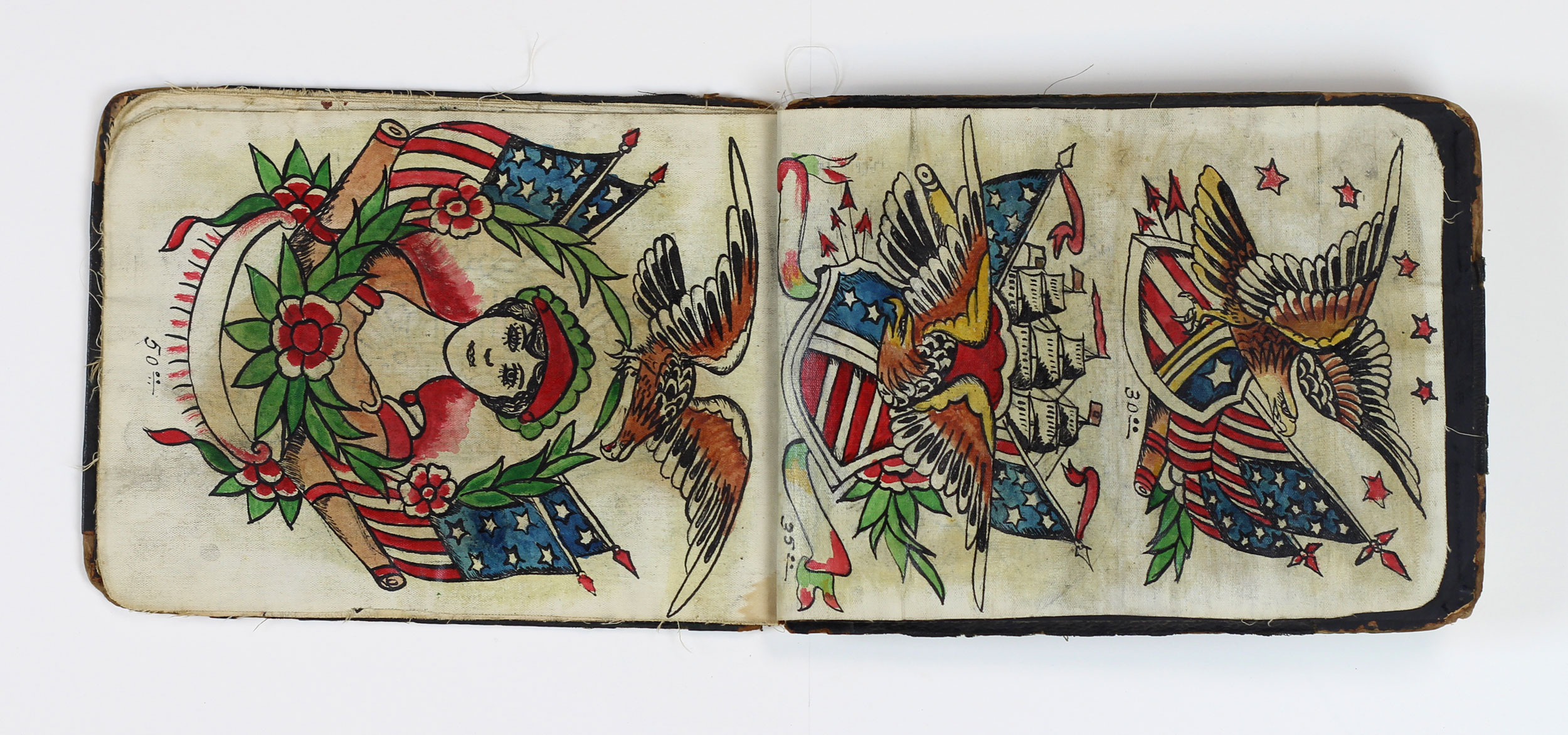
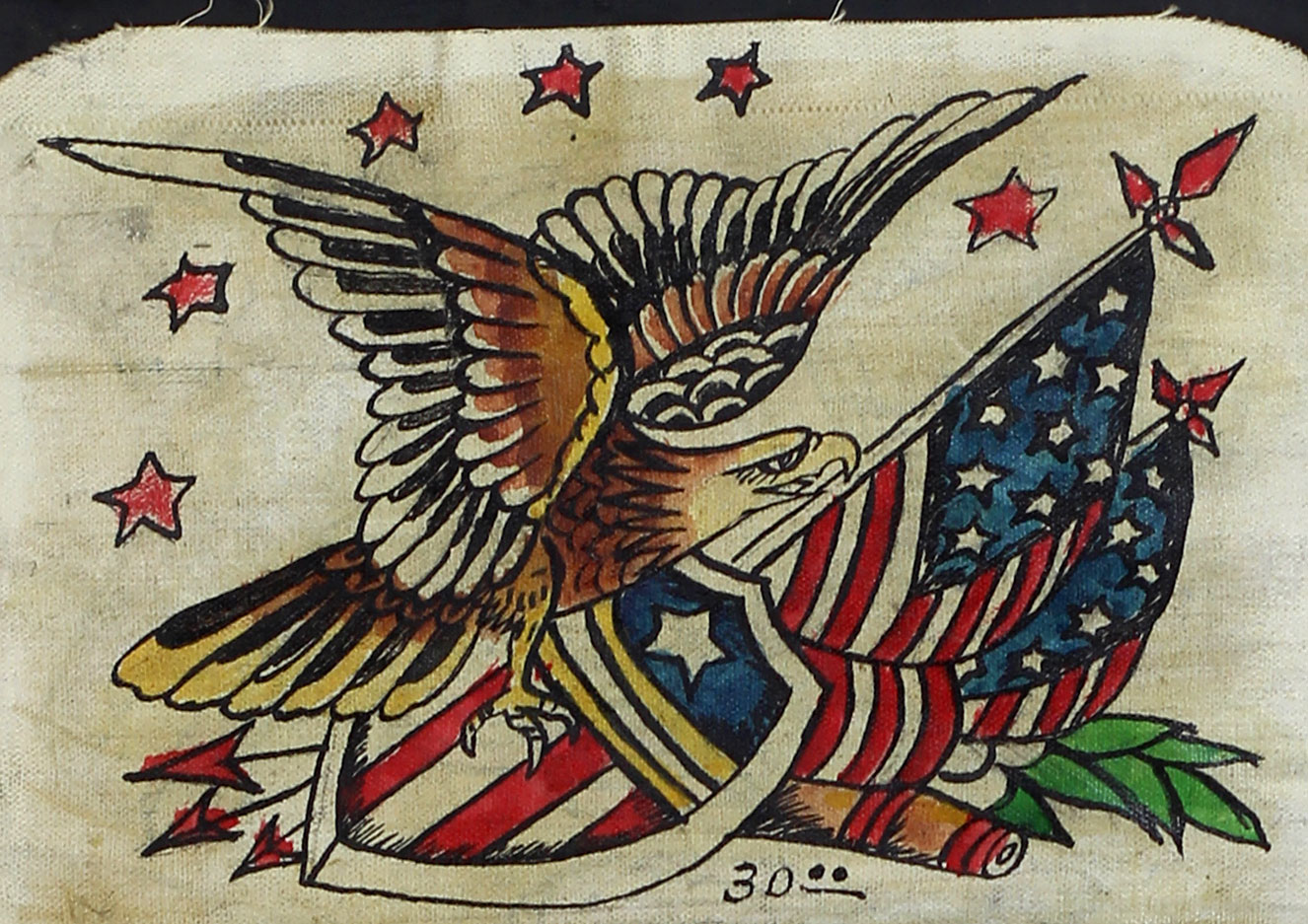

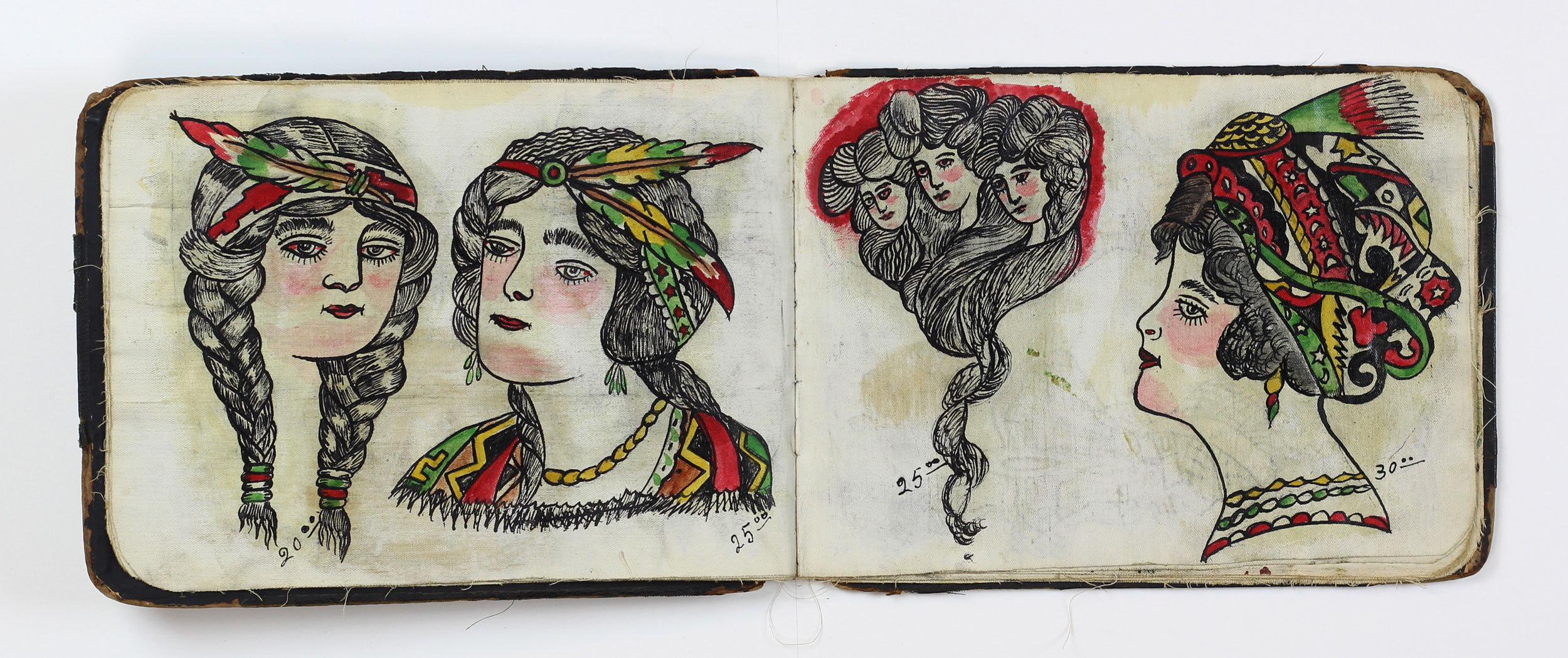



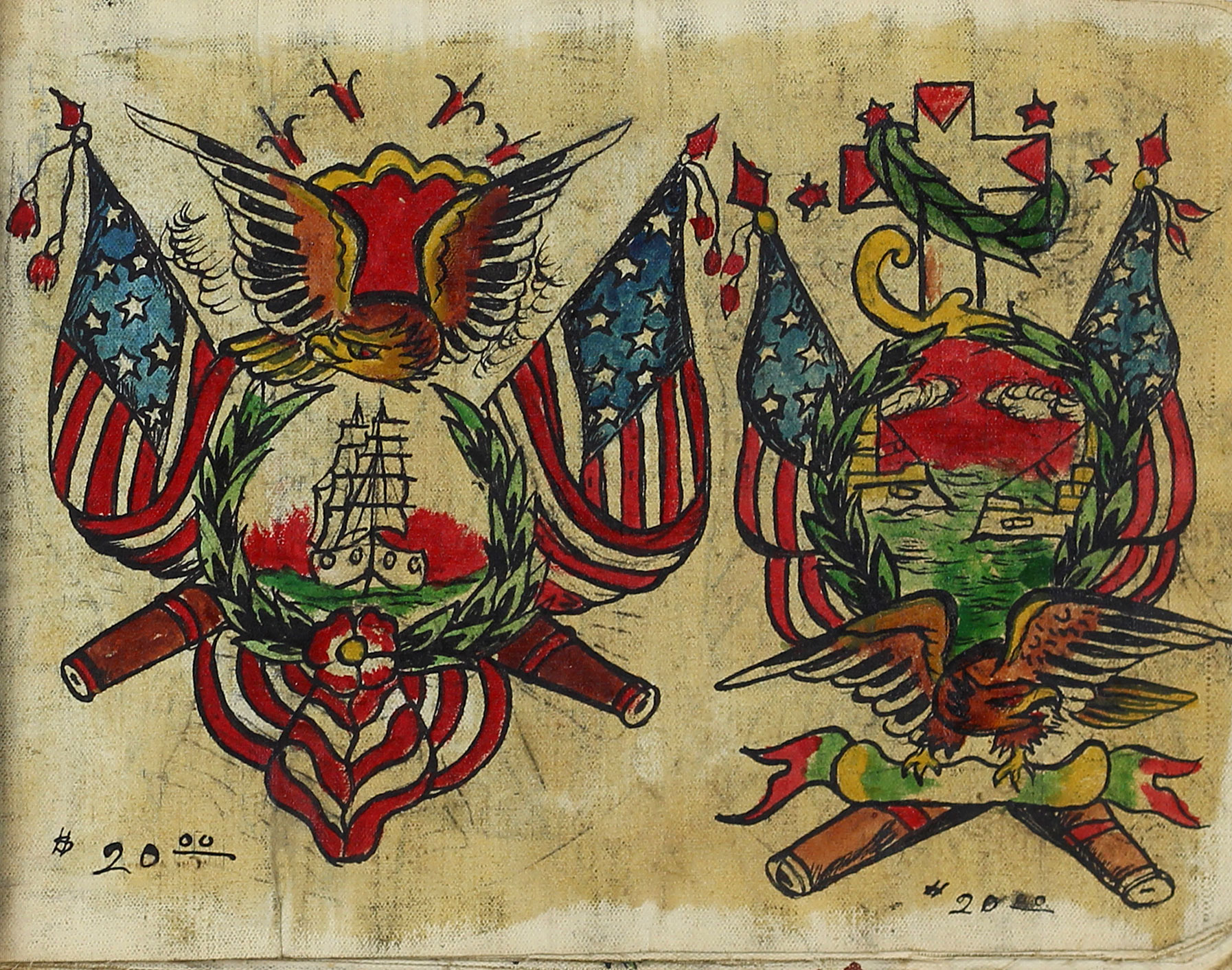


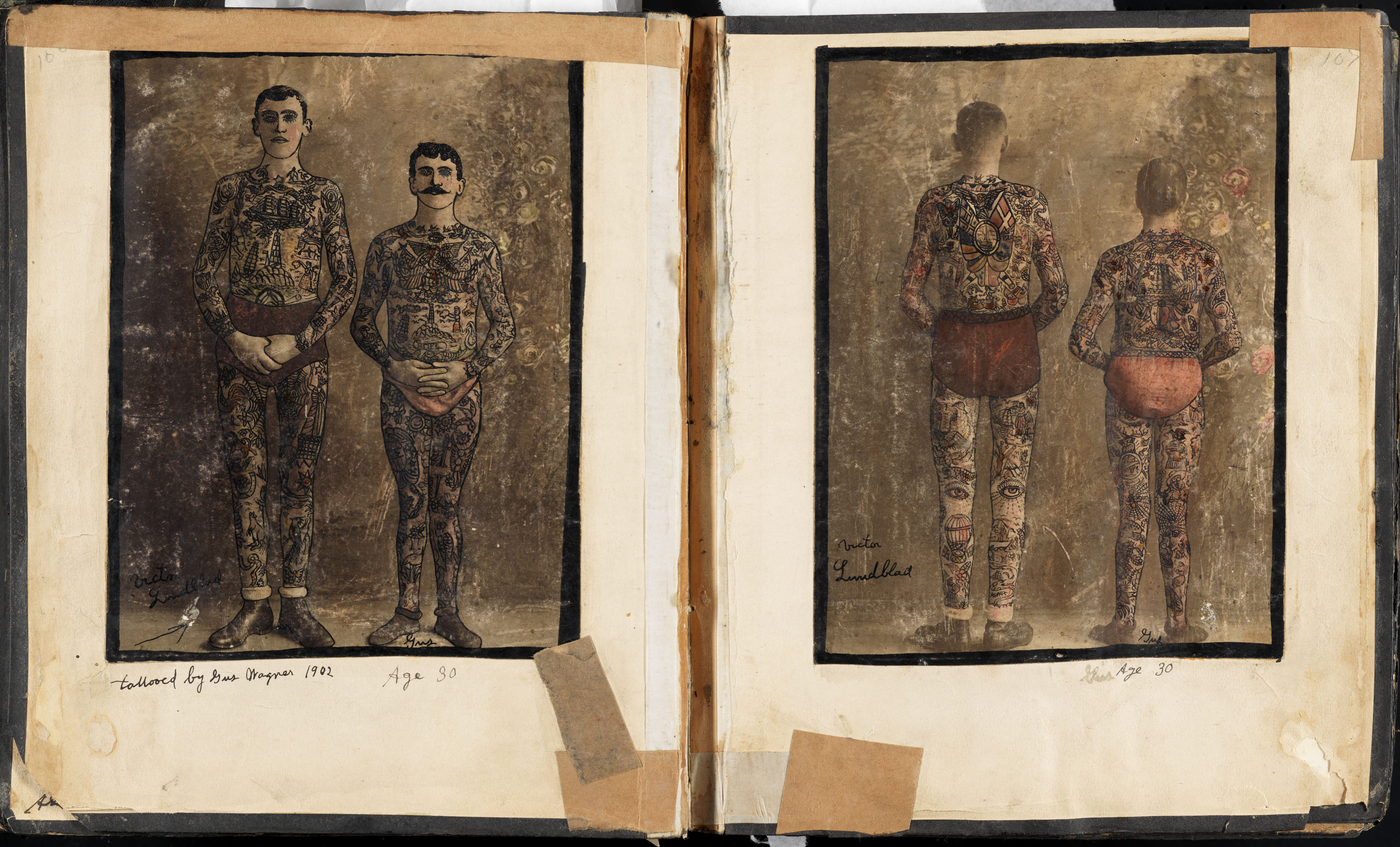
























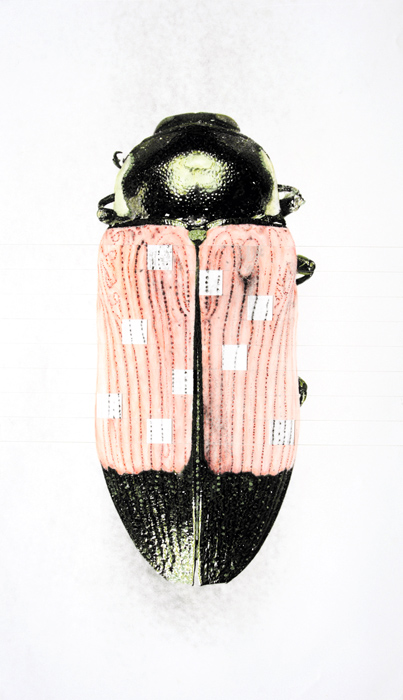


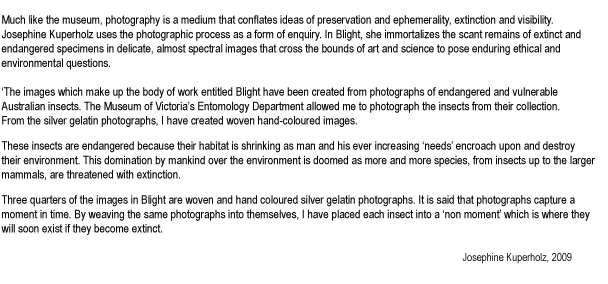

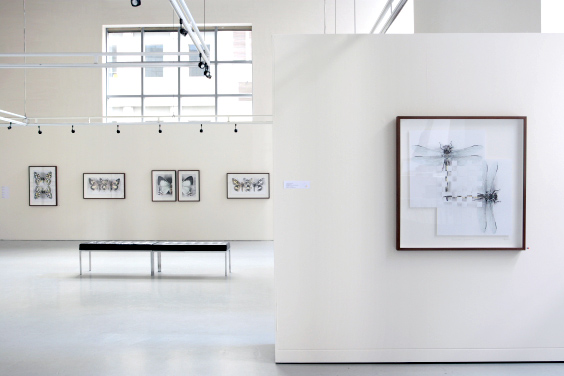
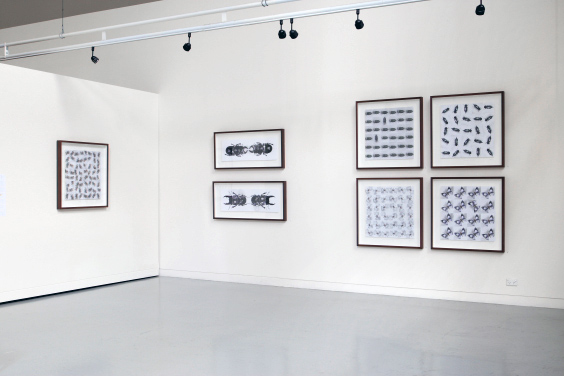
You must be logged in to post a comment.